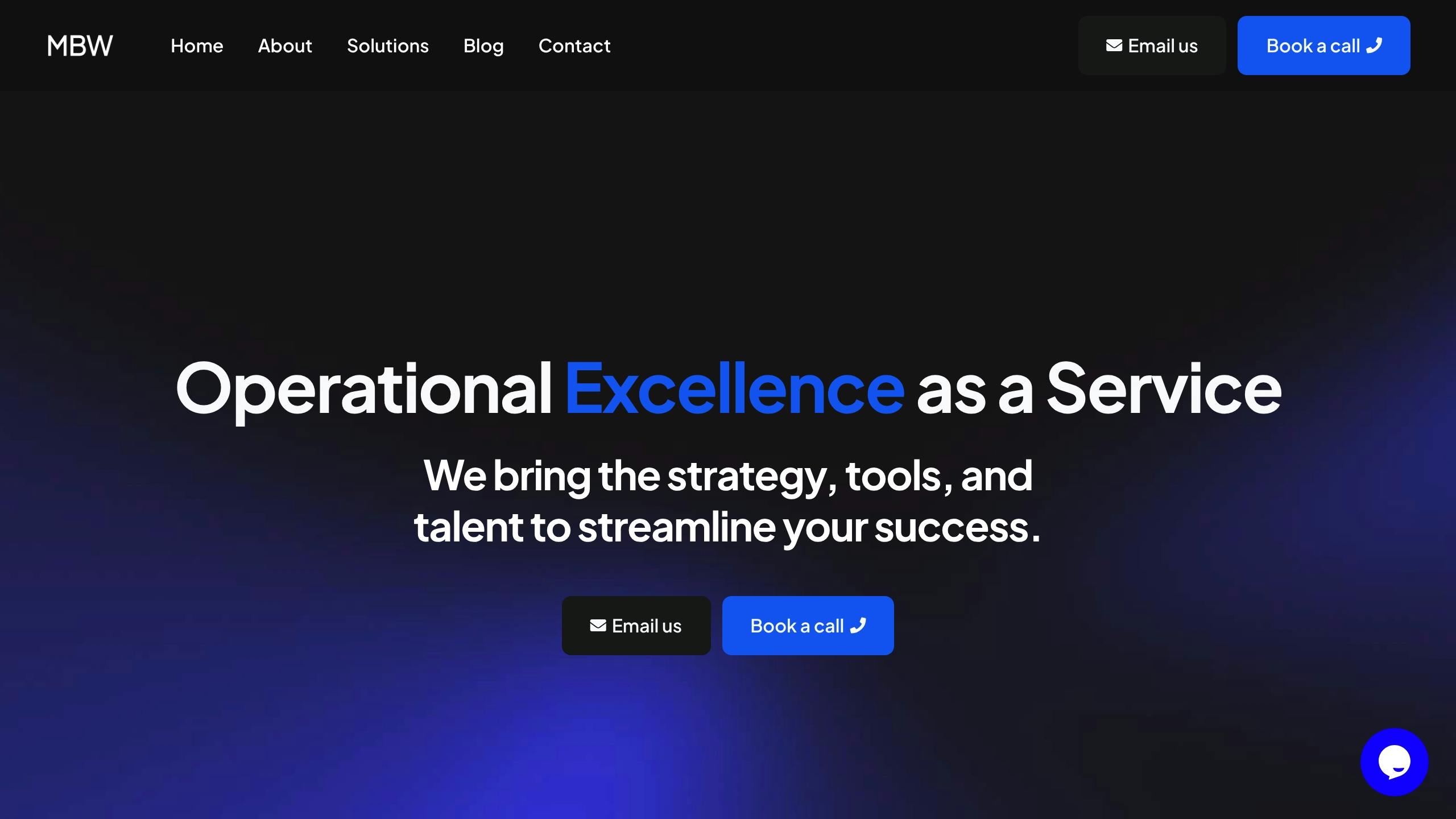Mar 24, 2025
AI Readiness: Assessing Workplace Culture - Modern Business Workers

AI adoption isn’t just about technology – it’s about preparing your workplace. Most digital transformation efforts fail because of poor workflows and lack of employee input. Here’s what makes a company ready for AI:
- Flexible Teams: Open to change and collaboration.
- Streamlined Processes: Fix inefficiencies before automating.
- Effective Training: Equip employees with the right skills.
- Trust in AI: Build confidence through transparency and ethics.
To succeed, start by improving workflows, training teams, and testing AI in controlled environments. Combine data insights with human expertise, and focus on clear communication. These steps ensure AI enhances your business without creating chaos.
Cultural Readiness for AI and Automation | Exclusive Lesson
Measuring Your Company’s Readiness for Change
Assessing your company’s readiness for AI involves looking at three key areas: employee attitudes, the effectiveness of training programs, and how new ideas are tested. These elements are the foundation for making adjustments that help your team adapt.
Staff Attitudes Toward New Tech
How your employees feel about adopting AI can make or break its success. To get a clear picture, use a mix of methods:
- Anonymous Surveys: Run regular surveys to gather honest opinions about AI and identify concerns.
- One-on-One Discussions: Schedule individual conversations to hear personal views and address specific worries.
- Behavioral Observation: Watch how teams currently use technology to spot potential challenges in adopting AI.
The insights from these efforts can guide the design of training programs that address real concerns.
Learning and Training Programs
Training is a critical step in preparing your team for AI. To evaluate the effectiveness of your training efforts, look at:
- How many employees complete the programs
- Knowledge retention and how well skills are applied
- Feedback from participants on the training experience
These metrics can help fine-tune your learning initiatives to better equip your workforce.
Testing New Ideas Safely
When introducing AI, it’s important to test new solutions in a controlled way. Set up a safe testing framework that includes:
- Dedicated Testing Environments: Keep AI pilots separate from production systems.
- Clear Success Metrics: Define what success looks like for each pilot.
- Regular Feedback Loops: Continuously gather input from end-users.
- Documented Lessons Learned: Record what worked and what didn’t after each test.
This approach lets you experiment with AI while protecting your core operations. Controlled testing helps you refine solutions without disrupting existing workflows.
Making Decisions with Data
Understanding data and making informed decisions are key to successful AI implementation. Once your organization is ready for AI, it’s crucial to improve core data practices.
Staff Data Skills
Evaluate your team’s data skills by checking their ability to:
- Interpret and understand basic data insights
- Recognize and apply data quality principles
- Identify key metrics relevant to your goals
- Use data visualization tools effectively
From there, focus on setting clear and consistent data standards to maintain high-quality outputs.
Data Rules and Standards
Clear governance ensures your data is reliable and ready for AI. To achieve this, establish standards that cover:
- Protocols for collecting data
- Procedures for validating data accuracy
- Checkpoints for quality control
- Permissions for data access
Research shows that roughly 60% of digital transformation efforts fail due to poor process mapping. A solid data framework allows you to combine analytical insights with practical, real-world expertise.
Combining Data and Experience
Successful AI relies on a blend of data-driven insights and human judgment. Building on earlier points about training and process improvements, here’s how to integrate these elements effectively:
| Decision Component | Role in AI Integration |
|---|---|
| Data Analysis | Provides objective metrics and trends |
| Human Expertise | Adds context and deeper understanding |
| Process Review | Highlights areas for improvement |
| Feedback Loops | Supports ongoing adjustments |
"Automation and AI are powerful tools, but they work best when built on top of well-optimized processes. Introducing automation to a disorganized or inefficient workflow will only magnify the problems. By first improving your processes, we create a strong foundation that ensures automation, AI, and other technologies deliver their maximum impact." – MBW
Before diving into AI, streamline your current workflows. This creates a strong base where both data insights and human expertise can thrive together.
sbb-itb-1a4ead8
Building Trust in AI Systems
Once you’ve established strong data practices and training, the next step is earning trust in your AI systems. This involves setting ethical standards, maintaining transparency, and promoting continuous learning. After grounding decisions in data, shift your focus to creating confidence in your AI tools.
AI Ethics Training
AI ethics training helps clarify what AI can and cannot do. These sessions should emphasize the following key areas:
| Training Component | Purpose | Implementation Focus |
|---|---|---|
| Ethical Guidelines | Define clear boundaries | Align with company values and industry norms |
| Bias Recognition | Spot potential problems | Focus on data collection and model outputs |
| Decision Impact | Understand consequences | Highlight effects on customers and stakeholders |
| Responsibility Chain | Establish accountability | Assign clear roles and oversight |
Building Confidence in AI
Help your team feel more comfortable with AI by providing hands-on experience and open communication. Start by showcasing how AI can simplify their daily tasks. Encourage confidence by:
- Testing AI tools in low-pressure scenarios.
- Sharing success stories across teams.
- Documenting and discussing both achievements and challenges.
- Offering regular updates on system improvements.
Transparent AI Decision Processes
Clear decision-making processes are key to trust and adoption. Lay out transparent protocols that include:
-
Documenting Decisions
Keep a record of every AI decision, including data sources, model parameters, and oversight checkpoints. -
Regular Reviews
Schedule periodic evaluations to check system performance and collect user feedback from across the organization. -
Encouraging Feedback
Set up channels where employees can voice concerns or suggest improvements, fostering collaboration and trust.
Consistent communication and well-defined procedures will go a long way in building trust in your AI systems.
Working Together on AI Projects
Bringing technical and non-technical teams together helps avoid mistakes and speeds up AI development. Strong alignment and open knowledge sharing lay the groundwork for successful implementation.
Connecting Teams
Collaboration across different functions works best with clear communication and well-defined roles. Here are some ways to strengthen team connections:
| Connection Area | Purpose | Implementation Strategy |
|---|---|---|
| Process Documentation | Keep track of workflows and roles | Create shared process maps |
| Regular Check-ins | Ensure alignment and solve problems | Hold weekly stand-ups and monthly reviews |
| Feedback Loops | Collect insights and refine processes | Use anonymous feedback tools and track actions |
| Knowledge Transfer | Share skills across teams | Host cross-training sessions and mentorships |
Once team connections are solid, sharing knowledge effectively can help build a stronger AI-focused culture.
Sharing AI Knowledge
A structured approach to sharing knowledge ensures everyone understands AI concepts and avoids information silos. Here’s how you can make it happen:
-
Create a Documentation Hub
Set up a central repository for project details, training materials, and success stories. Include process maps and best practices for easy access. -
Build Learning Networks
Encourage teams to share experiences through:- Monthly knowledge-sharing sessions
- Mentorship programs across departments
- Regular technical workshops
- Project reviews and retrospectives
-
Develop a Skill-Building Framework
Establish a clear plan for growing AI expertise. For example:Skill Level Focus Areas Learning Activities Foundational Basic AI concepts and terms Online courses, internal workshops Intermediate Data analysis, process improvement Hands-on projects, peer learning Advanced AI system integration, deployment Specialized certifications, technical training
Next Steps
To prepare for AI adoption, it’s essential to focus on a few key areas that will set your organization up for success.
Key Areas of Focus
Organizations should strengthen these three areas to be ready for AI:
| Area | Key Focus | Impact |
|---|---|---|
| Process Optimization | Simplify workflows | Greater efficiency |
| Technology Integration | Use AI and no-code tools | Automate tasks |
| Cultural Adaptation | Foster team collaboration | Better responsiveness |
How to Get Started
- Map out your current workflows and identify where inefficiencies exist.
- Lay the groundwork for change management by:
- Encouraging collaboration across departments
- Organizing skill-building workshops
- Maintaining clear communication channels
- Collecting and acting on continuous feedback
- Focus on improving workflows before implementing AI and automation tools.
Modern Business Workers‘ Role

Modern Business Workers provides comprehensive support for organizations aiming to develop AI-ready cultures. Their services include:
- Streamlining Processes: Expert assessment and improvement of workflows.
- Technology Integration: Seamless implementation of no-code automation and AI solutions.
- Team Development: Helping teams adapt through skill-building and collaboration.
This approach aligns with the steps outlined above, ensuring organizations are fully prepared for AI integration.
"We bring the strategy, tools, and talent to streamline your success." – MBWorkers
Given that nearly 60% of digital transformation projects fail due to poor process mapping, Modern Business Workers’ end-to-end services help organizations sidestep these challenges and create sustainable, AI-ready operations.